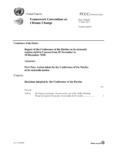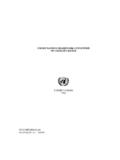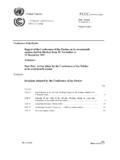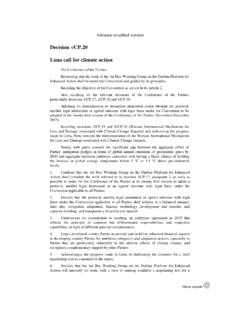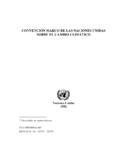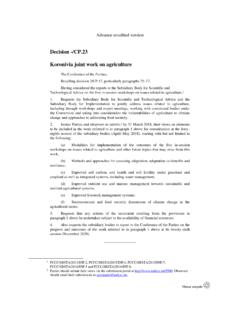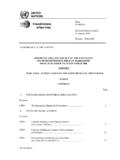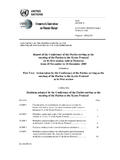Transcription of ROADMAP FOR CARBON RNC2050) - UNFCCC
1 ENROADMAP FOR CARBON NEUTRALITY 2050 (RNC2050) LONG-TERM STRATEGY FOR CARBON NEUTRALITY OF THE PORTUGUESE ECONOMY BY 2050 EnvironmentPortugalR 262 FOR CARBON NEUTRALITY 2050 (RNC2050) LONG-TERM STRATEGY FOR CARBON NEUTRALITY OF THE PORTUGUESE ECONOMY BY 2050 SUMMARYPREFACE1. FRAMEWORKI nternational and European frameworkNational complianceProgress made in reducing national greenhouse gas emissions2. VISION AND FUNDAMENTAL PRINCIPLES3. THE transition TO A COMPETITIVE, CIRCULAR, RESILIENT AND CARBON NEUTRAL ECONOMY 4. TRAJECTORIES FOR CARBON NEUTRALITY BY Role of the energy system in the transition to CARBON Power generation Mobility and Ind stria e processos Refining and petrochemical Chemical Iron and Pulp and Other Buildings - residential and Role of agriculture, forests and other land uses in the transition to CARBON NeutralityEmission reduction in livestock production and pasturesEmission reduction in crop production and agricultural landReduced emissions and increased sequestration in forests and other land Role of waste and wastewater in the transition to CARBON Neutrality Papel da economia circular na transi o para a Neutralidade Carb Co-benef cios da neutralidade carb nica para a qualidade do ar e sa de p blica5.
2 CONTRIBUTING TO NATIONAL RESILIENCE AND CAPACITY TO ADAPT TO CLIMATE CHANGE VULNERABILITIES AND IMPACTS6. STIMULATING RESEARCH, INNOVATION AND KNOWLEDGE PRODUCTION 7. GUARANTEE FINANCING CONDITIONS AND INCREASE INVESTMENT Savings on fossil fuel imports Impact on employment and GDP8. ENSURE A FAIR AND COHESIVE TRANSITION9. GUARANTEE EFFECTIVE CONDITIONS FOR GOVERNANCE AND ENSURE THE INTEGRATION OF CARBON NEUTRAL OBJECTIVES IN SECTORAL AREAS10. ENGAGE SOCIETY, FOCUS ON EDUCATION, INFORMATION AND AWARENESS AND CONTRIBUTE TO INCREASING INDIVIDUAL AND COLLECTIVE ACTION11. FINAL CONSIDERATIONSRESOLUTION OF THE COUNCIL OF MINISTERSP. 4P. 6P. 6P. 9P. 1 0P. 1 2P. 1 4P. 1 6P. 2 5P. 3 0P. 3 5P. 3 9P. 4 3P. 4 3P. 4 4P. 4 4P. 4 4P. 4 4P. 4 4P. 4 5P. 4 5P. 5 2P. 5 4P. 5 4P. 5 5P. 5 9P. 6 3P. 6 6P. 6 8 P. 7 0 P. 7 2P. 7 2P. 7 7P. 7 9P. 8 3P. 8 6P. 8 7 P. 8 9 P. 9 2P.
3 9 7 The signature of the Paris Agreement was one of the first official acts in which I had the privilege of participating as Minister of the Environment, responsible for the climate portfolio. A year later, at the COP 22 in Marrakech, the Prime-Minister committed to achieve CARBON neutrality by 2050, in a pioneering act of leadership, placing Portugal among those who advocate greater ambition in climate action. Our political orientation has been structured with a long-term vision, coupled with immediate action, around three interconnected axes: the valorisation of territory and habitats, a more circular economy and the decarbonisation of society and energy transition , with the ultimate objective being the promotion of wealth and 2050 CARBON Neutrality ROADMAP for Portugal (RNC2050) was developed in alignment with the territorial dimension included in the National Spatial Planning Policy Program and incorporating the orientations of the Circular Economy Action Plan.
4 I also highlight the unprecedented participation of the civil society, which was guaranteed throughout the different phases of the elaboration of the RNC2050 and allowed for a wide public discussion of its RNC2050 sets the path to CARBON neutrality in a sustained manner, establishes the main guidelines and identifies cost-effective options to achieve this end in different socio-economic development scenariosAccomplishing CARBON neutrality in Portugal implies reducing greenhouse gas emissions by more than 85%, compared to 2005, and ensuring an agricultural and forestry CARBON sequestration capacity of around 13 million tonnes. As Portugal is one of the countries that is most potentially affected by climate change, ensuring a sustainable and resilient agriculture and forest, and fighting desertification, are the biggest challenges we face, They must be coordinated with territorial cohesion and the protection of biodiversity, in order to ensure we achieve the said line with the results of the IPCC Report on C, it is by 2030 that the largest effort to reduce emissions will be placed, and this ambition has already been translated into the 2030 National Energy and Climate Plan, with a clear focus on energy transition and sustainable RNC2050 demonstrated that CARBON neutrality can be achieved with positive impacts on the economy and employment.
5 The transition to a CARBON neutral economy, together with the energy transition that is needed, implies a significant investment, being necessary to ensure social justice in the way investments are funded. In order to promote investments towards a CARBON neutral economy, Portugal initiated, in 2019, a debate about sustainable finance, which has led to the Letter of Commitment to Sustainable Financing in Portugal, that was subscribed by the large majority of the Portuguese financial CARBON neutrality implies changing from a linear, fossil fuel-based economic model to a circular, CARBON -neutral model. It implies a profound transformation of society as we know it. This is a process that brings challenges, but above all opportunities, and only with everyone s contribution will be possible to operate a just and cohesive have no time to hesitate. We can be flexible in solutions, but we cannot have margin on the set goals . Effective and ambitious climate action is must act before it is too late.
6 The path to CARBON neutrality is the path of the future. Jo o Pedro Matos FernandesMinister of the Environment and Energy TransitionPREFACEROADMAP FOR CARBON NEUTRALITY 2050 (RNC2050) LONG-TERM STRATEGY FOR CARBON NEUTRALITY OF THE PORTUGUESE ECONOMY BY 2050 RNC2050 LONG-TERM STRATEGY FOR CARBON NEUTRALITY OF THE PORTUGUESE ECONOMY BY 20506 INTERNATIONAL AND EUROPEAN FRAMEWORKThe Paris Agreement1, adopted in 2015, sets three overall objectives, namely, to limit the average global temperature increase to well below 2 C and to pursue efforts to limit the average global temperature increase to C, acknowledging that this would significantly reduce the risks and impacts of climate change; increase the ability to adapt to the adverse impacts of climate change and promote climate resilience and low CARBON development; and to make financial flows become consistent with resilient and low CARBON development Paris Agreement further stipulates that, to attain these objectives, it will be necessary to achieve CARBON neutrality in the second half of this century, establishing that all Parties to the Agreement must prepare and communicate in a successive and progressively more ambitious manner their Nationally Determined Contributions (NDC) to the global effort to reduce greenhouse gas (GHG) emissions.
7 In this context, all Parties are invited to submit, by 2020, their long-term development strategies with low GHG emissions2. This agreement marks a new era of global mobilisation to address climate change and represents a paradigm shift in the implementation of the United Nations Framework Convention on Climate Change ( UNFCCC ), with explicit acknowledgement that only with everyone s contribution is it possible overcome the challenge of climate the increase in global average temperature to C, in line with the most ambitious objectives of the Paris Agreement, requires an unprecedented transformation of modern societies and urgent and profound emission reductions in all sectors of activity, as well as changes in behaviour and the involvement of all parties. The Special Report of the Intergovernmental Panel on Climate Change (IPCC) on the impacts of an average global temperature increase of C above pre-industrial levels is decisive in affirming that human activities have already caused approximately 1 C of global warming over pre-industrial levels, with a likely range of C to C, and that, with current expected trends in global emissions, the C level will be reached between 2030 and of the average global temperature increase to C in relation to the pre-industrial period is crucial as it may prevent irreversible impacts of global warming.
8 The difference between an increase of C and 2 C is significant in terms of impacts and consequences for ecosystems and the economy, especially given that these are global average values and that the average temperature increase in more vulnerable areas of the planet could be even higher. The impacts of recent extreme events such as heat waves, droughts, floods and forest fires demonstrate the significant vulnerability and exposure to climate variability of some ecosystems and many societies. 1 2 Decis o 1 : RNC2050 LONG-TERM STRATEGY FOR CARBON NEUTRALITY OF THE PORTUGUESE ECONOMY BY 20507 The IPCC Special Report states that, in order not to exceed C of global temperature increase, global net anthropogenic CO2emissions should fall until 2030 by about 45% from 2010 levels, reaching CARBON neutrality by 2050. To keep the average global temperature rise below 2 C, global CO2 emissions must decrease by around 25% by 2030 and CARBON neutrality will have to be reached by 2070.
9 Emissions of other greenhouse gases also have to decrease significantly, to limit the temperature rise to either C or 2 C. These are global goals to be achieved by the countries of the world in the average global temperature increase within the limit of C is still possible but requires unprecedented change and urgent action to avoid the worst of its expected impacts and the costs associated with adapting our societies and economies to those impacts. The reduction of future damage will depend on the level of global warming that it is possible to avoid, and therefore on the rapid reduction of GHG emissions. In this context, it is crucial that as many countries as possible that are net emitters of GHG today achieve CARBON neutrality as soon as possible. It is widely acknowledged, and reinforced by the conclusions of the IPCC Special Report, that the later that measures known to be necessary and unavoidable are taken, the greater the costs of delayed action, and the more significant and rapid the GHG reductions will have to be in the post-2030 period.
10 In 20143 the European Union (EU) defined its goal for GHG reduction in the period from 2021 to 2030 by setting a binding target of at least 40% internal reduction of GHG emissions throughout the economy by 2030, compared with 1990 levels. This goal was embodied in the first EU Nationally Determined Contribution (NDC) for the 2030 horizon under the Paris Agreement commitments and underpinned the preparation of the 2030 Climate and Energy legislative framework. This Climate and Energy framework includes the EU-level policy targets and objectives for the period of 2021-2030, including at least a 40% reduction in GHG emissions (compared to 1990); at least 32% of energy derived from renewable sources4; and an improvement of at least in energy European Commission presented the Communication A Clean Planet for All , in November 2018, which proposes a long-term strategic vision for a thriving, modern, competitive economy that permits the achievement of zero net GHG emissions by 2050, providing the basis for the EU s long-term development strategy to be submitted to the UNFCCC under the Paris Agreement.
